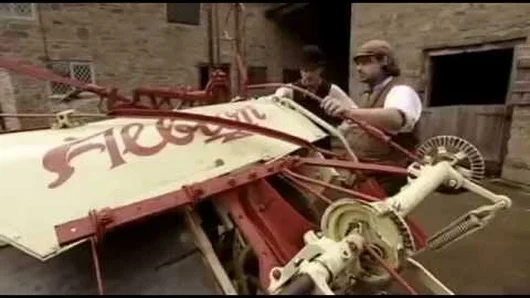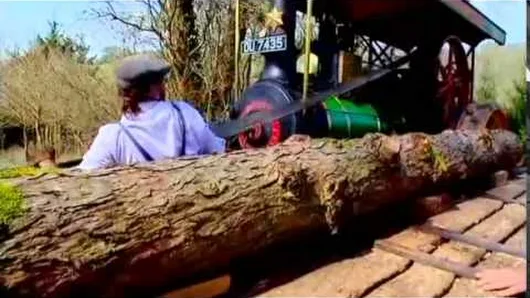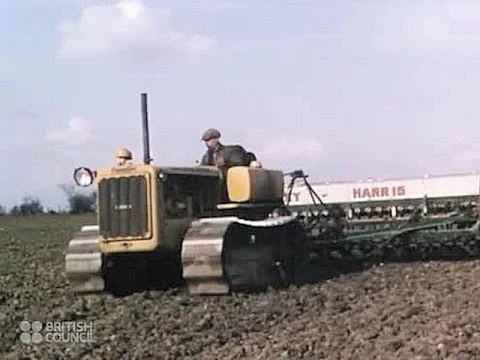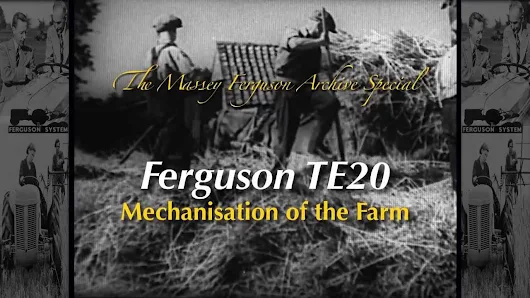https://www.youtube.com/watch?v=s_Hjdqs24Rw
https://www.youtube.com/playlist?list=PLrYzzr8yja6EoioMVKmiPBEQCb5yH96Zh
Farming Transitions
https://www.youtube.com/playlist?list=PLYZbCEPmWCtNZrzsWLLCauR4JKBvQ0BPP
19th century - Steam-powered farming innovation
https://youtu.be/ip0OnyCSsMU?t=33m20s
Paired steam tractors for ploughing - 19th century
https://youtu.be/ip0OnyCSsMU?t=34m18s
Full Steam Ahead - BBC 2016 - koggyb
https://www.youtube.com/playlist?list=PLltivhgN97V3pA599vy_pzuq32ESnZGZh
https://www.youtube.com/watch?v=s_Hjdqs24Rw
Horse-Drawn Reaper Binder, Victorian Farm
https://www.youtube.com/watch?v=vidzddSu0D0
Vintage Reaper Binder
https://www.youtube.com/watch?v=caHofifSgR8
Ford & Fordson tractors
https://www.youtube.com/watch?v=4d6P_6scKcQ
Working David Brown Tractors
https://www.youtube.com/watch?v=WhlgPWNl47E
Farming Father's Day
https://www.youtube.com/watch?v=vEly2tKxK6s
1930 Tractor Trials - science meets machine at World Tractor Trials
Royal Agricultural Society of England, Institute of Agricultural Engineering, University of Oxford
http://archive.commercialmotor.com/article/23rd-september-1930/64/how-the-tractor-trials-wpre-conducted
http://www.britishpathe.com/video/worlds-tractor-trials
Farming and Life on Dunstable Downs, WWII
http://www.bbc.co.uk/history/ww2peopleswar/stories/70/a7447070.shtml
Power - Mechanical - antharch
https://www.youtube.com/playlist?list=PLEFMsUiiH110QgUzZlu6hyL0kJFYUHt5k
Royal Agricultural Society of England, Institute of Agricultural Engineering, University of Oxford
http://archive.commercialmotor.com/article/23rd-september-1930/64/how-the-tractor-trials-wpre-conducted
http://www.britishpathe.com/video/worlds-tractor-trials
https://www.youtube.com/watch?v=UED_ivfD_g0
http://www.bbc.co.uk/history/ww2peopleswar/stories/70/a7447070.shtml
Power - Mechanical - antharch
https://www.youtube.com/playlist?list=PLEFMsUiiH110QgUzZlu6hyL0kJFYUHt5k
Steam-Powered Portable Sawmill, Edwardian Farm
https://www.youtube.com/watch?v=ejGktdtnoLY
Knowledge, Skill Sets, Inventions, Contraptions - antharch
https://www.youtube.com/playlist?list=PLEFMsUiiH113GgEaVnIE3QKvevYADqQX9
Farm & Industrial Machinery - Ben >> .
Fordson - notoriously hard to start; Ford 9N, Ford 2N; Massey-Ferguson
The first genuine Ford tractor, called the Fordson tractor (because a misleading Ford brand not related to Henry Ford was squatting on the Ford name at the time), was a tremendous success in North America and Europe from 1917 to 1928. Ford of the U.S. left the tractor business in 1928. Ford Ltd of Britain continued to thrive with the Fordson from 1928 onward. Some British Fordsons were imported to the U.S. during the following decade. Henry Ford continued tractor R&D in the U.S. after 1928. During the 1930s, experiments were made at Ford's Dearborn, Michigan and Richmond Plantation, Georgia facilities, creating prototypes of row-crop tricycle Fordsons, V8-powered tractors, one-wheel-drive tractors, and other ideas. But Henry Ford waited to reenter the market, planning to have the right new tractor at the right time to achieve a market-changing success.
In Ireland, businessman Harry Ferguson had been developing and selling various improved hitches, implements, and tractors since the 1910s. His first tractors were adapted from Model T cars. In 1920 and 1921 he gave demonstrations at Cork and Dearborn of his hitches and implements as aftermarket attachments to Fordson tractors. The hitches were mechanical at the time. By 1926, he and a team of longtime colleagues (including Willie Sands and Archie Greer) had developed a good hydraulic three-point hitch. Ferguson put such hitches on Fordsons throughout the 1920s and early 1930s. In the mid-1930s, he had David Brown Ltd build Ferguson-brand tractors with his hitches and implements. In 1938, Eber Sherman, importer of Fordsons from England to the US and a friend of both Ford and Ferguson, arranged to have Ferguson demonstrate his tractor for Henry Ford. In October 1938 the Ferguson tractor was put through a demonstration before Ford and his engineers. It was light in weight relative to its power, which impressed Ford. Ferguson's successful tractor demonstration led to a handshake agreement with Ford in 1938, whereby Ford would manufacture tractors using the Ferguson three-point hitch system.
Ford Motor Company invested $12 million in tooling to finance Ferguson's new distribution company. The investment resulted in the production of the 9N tractor which was introduced on June 29, 1939. It was officially called a "Ford tractor with the Ferguson system", although the name Ford-Ferguson was widely used. It sold for $585 including rubber tires, power take-off, Ferguson hydraulics, an electric starter, generator, and battery; lights were optional. Ford's 9N further improved the cantankerous Model F by updating the ignition with a distributor and coil. An innovative system of tire mounts for the rear wheels and versatile axle mounts for the fronts enabled farmers to accommodate any width row-crop work they needed. The 9N weighed 2340 pounds and had 13 drawbar horsepower, which could pull a two-bottom plow. It was designed to be safe, quiet and easy to operate. Ford once said "Our competition is the horse."; the 9N was intended for farmers who were not mechanically minded.
An immediate success, the 9N's configuration became an industry standard, which was followed by other tractor manufacturers for fifteen years. Henry Ford passed leadership of his company to grandson Henry Ford II in 1945. By 1946, the younger Ford discovered that, despite its success, the Model N lost Ford Motor Company over $25 million in six years. He reacted by forming Dearborn Motors in November 1946, which took over tractor distribution from Ferguson. Ford informed Ferguson that after July 1947 they would no longer supply tractors to his company. Ferguson sued Henry Ford II, Dearborn Motors and Ford Motor Company and others for $251 million in damages on the basis of patent infringements and conspiracy to monopolize the farm tractor business. Ford Motor Company claimed the patents had already expired by the time of Dearborn Motors' incorporation.[3] Approximately 750,000 9Ns were built, and it was estimated in 2001 that nearly half of these were still in regular use.
Harry Ferguson had understood that the handshake agreement had included the manufacture of the 9N in Britain. World War II intervened and prevented this, although one explanation was that Ford UK was uninterested in the plan.
9N
The first tractor of the series was the 9N, the first tractor to have both three-point hitch and a rear Power Take Off. The 9N was first demonstrated in Dearborn, Michigan on June 29, 1939. Its model name reflected a model-naming system using the last digit of the year of introduction and a letter for product type, with "N" for tractors (hence 9N). Like the Farmall, it was designed to be a general-purpose row-crop tractor for use on smaller farms. An extremely simple tractor, the 9N was fitted with the Ferguson system three-point hitch, a three-speed transmission, and featured footpegs instead of running boards. The 9N's relatively tall and wide-spaced front wheel design resulted in somewhat sluggish steering and reduced maneuverability compared to competing machines such as John Deere's Models A and B, and the Farmall 'Letter series'. But the 9N did have variable front track, a valuable feature for row-crop cultivation, via front half-axles that could be slid in and out and pinned in place. It also had variable rear track via the reversible offset of the rear wheel design (flipping the rear wheels around 180°, moving the formerly inboard side to the outboard side, widened the rear track). Uniquely, the exhaust was routed underneath the tractor, much like an automobile. All 9N tractors were painted dark grey. This tractor has a rear Power Take Off (PTO) which could be used to drive three point or towed implements. The Ferguson hitch was designed to solve some of the problems found in the earlier Fordson tractors such as flipping over if the plow hit an obstruction. The upper link also would adjust the hydraulic lift to use the drag of the plow to improve traction. This was known as draft control.
The original 9N engine was a four cylinder engine and was designed to be powered by distillate fuels. The engine shares the same bore and stroke sizes as one bank of the Ford V8 automobile engines. A few standard Ford auto and truck parts such as timing gears and valve tappets were used in this engine.
The ford 9N engine was a side valve, four cylinder engine, with a 3.19-inch (81 mm) bore, 3.75-inch (95 mm) stroke, providing a displacement of 120 cubic inches (2,000 cm3). The transmission was the standard three speed.
The finished tractor weighed 2,340 pounds (1,060 kg), and initially sold for US$585. This was an advantage as tractors from other manufactures cost almost twice as much.
2N
The 9N was revised a number of times, until being relaunched as the 2N in 1942. The 2N still came in dark grey, but now had added improvements including a larger cooling fan and a pressurized radiator. However, the 2N, like the 9N, still had only a 3-speed transmission, a disadvantage compared to many tractors at the time, such as the Farmall A and M. By this time, wartime regulations had imposed manufacturing economies, and some 2Ns can be seen with all-steel wheels. Batteries were reserved for the war effort, so the all-steel wheel tractors came with a magneto ignition system instead of a battery and had to be started with a hand-crank.
Introducing a new model name also allowed Ford to raise the price of the tractor. Wartime price controls prevented the raising of prices on existing models, but they could not determine the price of a "new" model. Despite the model name change, the serial numbers continued to be prefixed with "9N".
After the war the steel wheels and magneto system were replaced with rubber and batteries.
In 1945 due to Henry Ford's failing health, Henry Ford II, his grandson, took over the Ford Motor Company. Since the original agreement between Ford and Ferguson was sealed with a handshake (versus a written contract) and included the notion that either party could terminate it at any time without reason, Henry Ford II didn't feel the need to continue to honor it [fool!]. Ferguson was furious and sued Ford Motor Company. A few years later his Ferguson interests were merged with Massey Harris, a Canadian company, to become Massey Ferguson.
https://en.wikipedia.org/wiki/Fordson
https://en.wikipedia.org/wiki/Ford_N-Series_tractor
Tractors Working On The Farm: Power On The Land - 1943
https://www.youtube.com/watch?v=FgasD-N0yL8
Farm, Timber, WLA, WTC
https://www.youtube.com/playlist?list=PLtakTnKQQMCx3Np0zsgSkr9ih0A0w2m4V
History of Farming
https://www.youtube.com/playlist?list=PL43UrdpDUR9-FRKR3tLHUgmZp0LpgMO2y
Tractors - Ferguson, Massey-Ferguson playlist
https://www.youtube.com/playlist?list=PLYZbCEPmWCtMdtMh_eiqTMtWhgH6m2kVk






No comments:
Post a Comment
Note: Only a member of this blog may post a comment.